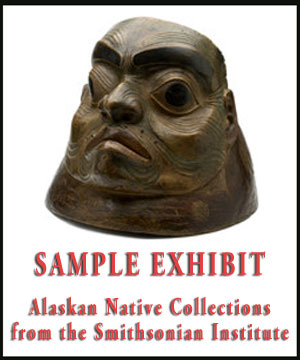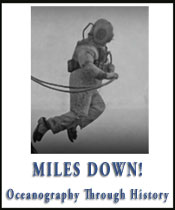World Ocean Exhibits
Sept. 2015: This page is a work in progress. Please check back soon.
 |
 |
 |
 |
 |
 |
 |
||
For more information about a specific exhibit, please contact us.
World Ocean Observatory offers a variety of exhibits that can be downloaded and installed at your institution. These exhibits are focused, evocative, timely, and are made possible through the support of our sponsors. They will fit in small spaces, are economical to produce, and are well-suited for schools, libraries, museums and aquaria, and any other educational organization. Available at no charge, they require minimal production and audio-visual equipment to install. Additional exhibits are forthcoming. For further information, please contact us.
The following World Ocean Observatory Exhibits are under development:
Miles Down!
The History of Oceanography
The history of oceanography is an international story of invention, individual adventure, and exploration that remains unknown to many.This exhibit will present an historical overview, illustrated by individual profiles and expedition accounts from the United States, France, Germany, Japan and the former Soviet Union. The exhibit incorporates text, documents and photographs, and may be supplemented by objects from the presenter's collection when available.
People of the Sea
Portraits of Maritime Communities around the World
Through brilliant photography, text and simple media, this exhibit will portray unique maritime communities engaged with the ocean for sustenance, community and culture. Subjects include such examples as cod fishing in Norway, seining in India, ship breaking in Bangladesh, oyster farming in Chile, seaweed harvesting in Japan, sail training in Indonesia, and native whaling and sealing in the Arctic, among others.
The Boat
What it is. How it Works. What it Means.
The boat is a ubiquitous tool for all cultures. From the birch-bark canoe to the square-rigged ship, from the coastal trawler to the submarine, boats have been constructed in numerous forms, from every material, in response to particular challenges posed by the sea. The boat is the answer to many questions: a technological adaptation to the hunt for a particular species in a particular habitat, and a human response to the needs of the individual, the family, and the community to exploit the ocean to survive. This exhibit demonstrates the multiple functions of the boat, its powerful flexibility, and its role as a focus for cultural expression. Photographs, text, and media may be supplemented by objects from the presenter's collection when available.
The Circle of Fresh and Salt
How the Hydrological Cycle Affects our Daily Living
This science exhibit defines the synergy between the ocean and freshwater expressed by the natural system of exchange and transformation known as the hydrological cycle. The exhibit explains the chemistry, physics, and biology inherent in the cycle, details its complex range of effects and consequences for our daily lives, and project the possible negative implications for the future should the process be mismanaged or interrupted by human activity.
Into the Northern Ice:
The Story of Arctic Exploration
Few subjects have captured the public imagination as dramatically as the stories of explorers in search of the North Pole, the Northwest Passage, and the Western Sea. The expeditions are many and are filled with stories of heroics and folly, of incredible endurance, of human ambition and aspiration, as to this day men and women test themselves against the ice and cold. This exhibit provides a chronology of exploration in the north and profiles a series of known and less known individuals whose experience demonstrates the depth of human curiosity and the drive to discover.
The Law of the Sea
How Do We Govern the Ocean Commons?
More than 100 countries have ratified the UN Convention for the Law of the Sea, the first global attempt to outline a system of governance for the vast ocean that lies outside the territorial jurisdiction of individual nations. The convention is controversial and has generated much debate between developed and developing economies, north and south, and advocates for national sovereignty versus global interdependence. The exhibit explains the context for the system and the principles on which it relies. It outlines the content of the Convention and its evolving implications for future exploitation of food and energy resources, scientific discovery, protection of cultural artifacts, safe passage and protections for world shipping, medicine and public health, trade and governance.
Organizations interested in presenting these exhibits should contact us.



